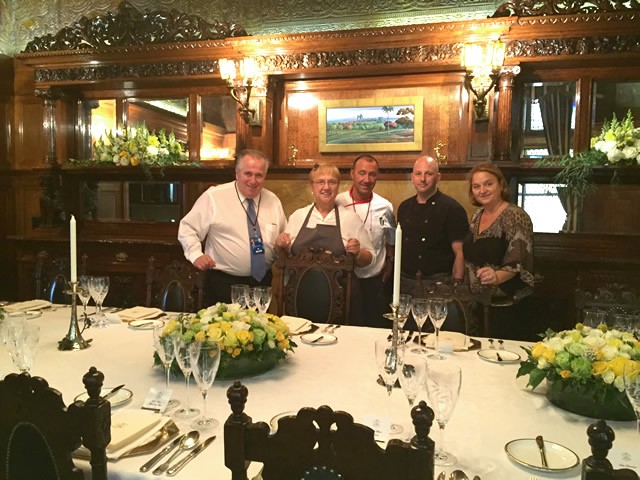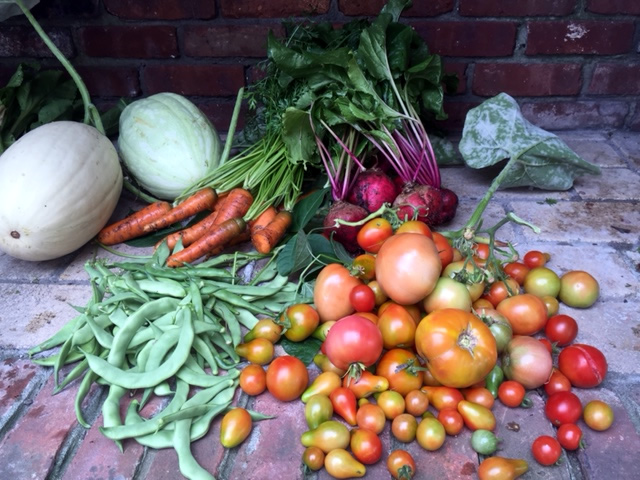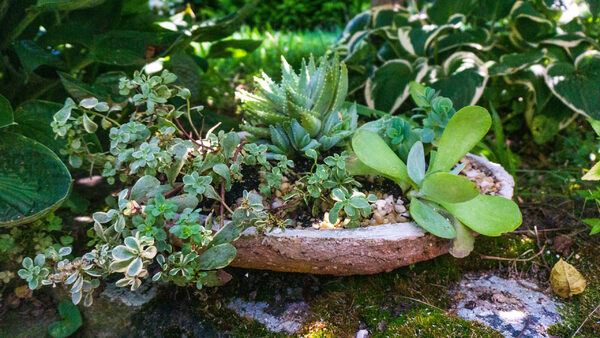

From “What The Chef Grows” featured in the March/April 2016 Issue of Fine Gardening Magazine (page 44).
Exerpt: “Most people wouldn’t argue that I know my way around a kitchen. What many don’t know, though, is that I know my way around a garden, too. I learned how to garden—and subsequently cook—from my grandmother. Nonna Rosa, who lived in Italy, grew much of the food that was brought into our kitchen. It was during this time in my childhood that I came to a realization: To get the best ingredients, sometimes you had to plant them. There is nothing better than knowing an essential part of a recipe was grown by you and freshly picked by you. Years later, when I bought a home and started my own family in Queens, New York, I knew a garden was something that I couldn’t be without. For over 30 years now, I—along with my mother, Erminia—have started scores of veggies from seed and planted them in my chef’s garden. Aside from ‘Genovese’ basil and ‘Roma’ tomatoes, you’ll find several lesser-known veggies that I consider essential favorites, including the ones featured here.”
The papal menu was created at Lidia’s flagship restaurant, Felidia, and includes several of its signature dishes such as Cacio e Pere, the famous pear and pecorino ravioli, along with simple appetizers using local produce and herbs from Lidia’s home garden. Below are the recipes for:
- Caprese di Astice e Burrata
- Cacio e Pere
- Sorbetto di Uva Fragola con “Torta degli angeli”

Caprese di Astice e Burrata
Heirloom Tomato, Housemade Burrata, Steamed Maine lobster
Serves six as an appetizer salad
Ingredients:
- 1 teaspoon kosher salt, plus 6 tablespoons for the lobster pot
- 2 live lobsters, 1¼ pounds each
- 3 or 4 ripe fresh tomatoes (about 1½ pounds), or 1 pound sweet, ripe cherry tomatoes
- 2 or 3 tender stalks celery with a nice amount of leaves
- Juice of 2 large lemons, freshly squeezed (about ⅓ cup)
- 2 burrata shredded, let steep for 30 minutes – (about 11/2 cup)
- ¼ teaspoon peperoncino flakes, or to taste
- ¾ cup extra-virgin olive oil
- 2 tablespoons chopped fresh Italian parsley
Directions
- Fill the pot with 6 quarts water, add 6 tablespoons salt, and bring to a rolling boil. When the water is at a rolling boil, drop in the lobsters and cook them, uncovered, for exactly 10 minutes after the water returns to the boiling point (and then keep it boiling). At the end of 10 minutes (or a couple of minutes longer if the lobsters are larger than 1¼ pounds), lift the lobsters from the pot, rinse with cold water, drain, and let them cool.
- Core and cut the tomatoes in half, squeeze seeds out, reserve juice then cut into ½ inch . Chop the celery stalks crosswise into ½ -inch pieces, and roughly chop the leaves. Toss the tomatoes and celery together in a large bowl with ½ teaspoon of the salt.
- When the lobsters are cool enough to handle, twist and pull off the claws and knuckle segments where the knuckles attach to the front of the body. Lay the clawless lobsters flat on a cutting board, and split them in half lengthwise, from head to tail, with a heavy chef ’s knife. Separate the meaty tail piece from the carcass (or body) of the four split halves.
- Cut the lobster body meat into pieces of whatever size you like, putting the clean pieces in a large mixing bowl as you work. Separate the knuckles from the claws, and crack open the shells of both knuckles and hard claw pincers with the thick edge of the knife blade, or kitchen shears, exposing the meat. Remove the meat from the knuckles and claws.
- Cut the tail pieces crosswise into 1 inch chunks, or leave them whole (which I prefer).
- To make the dressing: Whisk together the lemon juice, peperoncino, and remaining ½ teaspoon salt. Pour in the olive oil in a slow stream, whisking steadily to incorporate it into a smooth dressing.
- To serve: add the tomatoes and celery to the bowl of lobster pieces. Pour in the dressing, and tumble everything together until evenly coated. Scatter the parsley on top. To serve on flat plates place the burrata shreds around the plate drizzling the remaining cream around the plate. Divide the dressed lobster and vegetables and scatter on top and around the burrata on the plate. Drizzle remaining dressing.
Cacio e Pere
Pear and Pecorino filled Ravioli
This delicate and quite simple ravioli is a lovely way to enjoy the affinity of pear and cheese. The filling is a lively blend of shredded ripe pear, shredded 3 to 6 months aged Pecorino Romano, Grana Padano and mascarpone—just stirred together at the last moment. Makes one pound of pasta for 20 to 24 ravioli.
Ingredients for the dough:
- 2 cups all-purpose flour
- 1 egg yolk (from a large egg)
- 3 large whole eggs
- 2 tablespoons extra-virgin olive oil
Directions for the dough in the food processor:
- Fit the regular steel cutting blade in the bowl of the processor.
- Measure the flour into the bowl; process for a few seconds to blend and aerate.
- Drop the eggs and egg yolk into a spouted measuring cup or a small bowl; beat briefly with a fork to break them up. Mix in the measured amounts of oil and water. Start the machine running with the feed tube open. Pour the wet mixture into the bowl quickly; scrape all the egg drippings out of the cup into the processor too.
- Let the machine run for about half a minute: a dough should form quickly, most of it should clump or ball up onto the blade—some may spread on the sides of the bowl—where it will twist and knead. If too loose add a tablespoon or two of flour; if still crumbly add a teaspoon or two of cold water.
- Let the machine knead the dough for about 10 seconds . Turn the dough out on a very lightly floured surface and knead by hand for another half minute or so, until it’s smooth, soft and stretchy. Wrap and rest the dough for 30 minutes.
Ingredients for the filling:
Makes 2 cups of filling
- One large, 1/2 pound, firm ripe Bartlett pear or 2 small pears. (Most pears will make a good filling as long as they are ripe but firm.)
- 6 ounces freshly shredded 3 to 6 months aged Pecorino Romano
- 1 cup grated Grana Padano
- 1-1/2 tablespoons chilled mascarpone
Directions for the filling:
- Peel and core the pear and shred it against the large holes of a box grater.
- Stir the shreds with the shredded cheese in a bowl.
- Add the grated Grana Padano then blend in the mascarpone. Mix all well.
Making the Ravioli:
- Cut the dough into four pieces. Work with one piece at time and keep the others moist in a closed plastic bag.
- Roll the first piece of dough using the machine method—make sure your strips are 5-inches wide on the first setting.
- When you have stretched the dough to approximately 20-inches—having narrowed the setting twice—cut it crosswise into two 10-inch strips.
- Roll each of these to 20-inches— long enough for 5 ravioli. Measurements need not be exact; if your dough stretches to 24-inches, make 6 ravioli, or if your strips are a bit shorter, that’s all right, too.
Filling and Forming the Ravioli:
- Lay the two strips out on a very lightly floured surface. The strips should be the same length and width: stretch them gently by hand to widen or lengthen as needed. If one strip is clearly wider than the other, use that as a top strip to drape over the filling. Keep the strips covered with a moist cloth to prevent drying.
- With a scoop or a spoon (or your fingers), place a measured amount of filling in a mound on the left or right end of your designated bottom strip. The center of the mound should be 2 inches in from edge. Place the next portion of filling 4-inches from the first, measuring center to center of the mound. You should have room for 5 or 6 mounds on the strip, Press the top of the mounds lightly to flatten and spread them just a bit.
- Brush a thin strip of beaten egg along the top, bottom and side edges of the dough strip and right in between each mound of filling.
- Pick up the top strip and drape it over the filling mounds, lining up the edges with the bottom dough strip on all sides and stretching it gently so it covers the bottom completely.
- Now press the dough layers together lightly but only along the stripes of egg “glue.” Do not press the dough together in the clear area around the filling mounds—in fact, you want to leave a bit of air space in each of the ravioli. If you see a big bubble of air around the filling, though, push it out gently before you’ve pressed the edges together. Press the filling, flattening it lightly.
- With your pastry cutting wheel, cut along the top, bottom and side edges of the ravioli strip in straight lines, trimming away as little of the dough as possible, then cut in between the mounds, separating the ravioli.
- Arrange the finished ravioli on the lightly floured towel-lined or parchment-lined tray—check each one and pinch the edges closed any edges that may not be well sealed. Cover with a cloth and make more ravioli from the next piece of dough.
Ingredients for the sauce:
- 6 ounces butter
- 4 ounces mild 12 months Pecorino Romano, grated
- Abundant coarsely ground black pepper, to taste
Saucing in the Skillet and Finishing:
- Cook the ravioli in 6 quarts of boiling salted water. Meanwhile, heat the butter until simmering in the large skillet and thin it with a cup of the boiling pasta water.
- Lay the cooked ravioli in the skillet and coat with the hot butter.
- Remove the pan from the heat and sprinkle over the grated aged Pecorino, mixing gently so the cheese begins to melt into a sauce, then grind coarse black pepper all around.
Sorbetto di Uva Fragola con “Torta degli angeli”
Concord grape sorbetto with Angel food Cake
This is a simple and light dessert that you will make over and over again in many different ways. It is great by itself, with some chocolate or fruit syrup poured over it, or topped with ice cream and berries. In the winter, I like it with poached or baked winter fruits, such as pears, apples, or quince. Serves eight.
Ingredients:
- 1 cup cake flour
- 1½ cups confectioners’ sugar, plus more for dusting the cake
- Pinch kosher salt
- 12 large egg whites, at room temperature
- 1 teaspoon cream of tartar
- 1 cup granulated sugar
- 2 teaspoons vanilla extract
- Zest of 1 lemon, grated
- Fresh berries, for serving
Directions:
- Preheat the oven to 350 degrees F. Sift together the flour, confectioners’ sugar, and salt onto a piece of parchment paper.
- In a mixer fitted with the whisk attachment, beat the egg whites and cream of tartar until foamy. While beating on -medium–high, gradually add in the granulated sugar, and beat until stiff peaks form, about 5 minutes. Add the vanilla and lemon zest, and mix in.
- Remove the bowl from the mixer, and fold in about a third of the flour mixture. Gently fold in the remaining flour in two more additions.
- Scrape the batter into a -10–inch ungreased tube pan. Do not grease the angel food baking pan; since this is basically a meringue cake, it needs to climb the sides of the pan while baking. This will not happen properly if the pan is greased. Bake until the top is lightly golden and a toothpick inserted in the center comes out clean, about 45 minutes.


















Comments
Log in or create an account to post a comment.
Sign up Log in